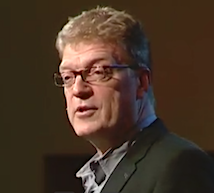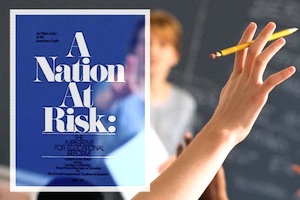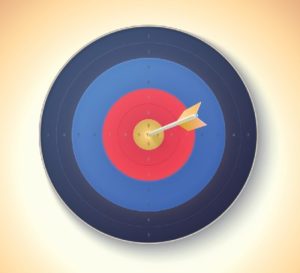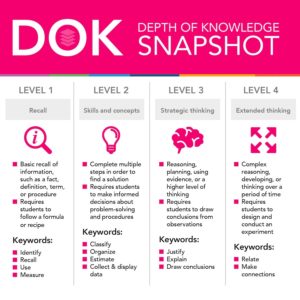Overcome the Status Quo with Mastery Learning
A MiddleWeb Blog
 It is the rare teacher in 2021 who has not seen or heard Sir Ken Robinson’s famous TED talk on public education and how it kills creativity.
It is the rare teacher in 2021 who has not seen or heard Sir Ken Robinson’s famous TED talk on public education and how it kills creativity.
Presented in 2006 and posted online a year later, his 20-minute speech has since been viewed well over 69 million times. If you happen to be one of those few who haven’t seen or read the transcript of this talk, you can watch it here.
Sir Ken passed in August 2020, but his words linger. Here is part of what he said:
“Every education system on earth has the same hierarchy of subjects. Every one. Doesn’t matter where you go. You’d think it would be otherwise, but it isn’t.

“… Now our education system is predicated on the idea of academic ability. And there’s a reason. The whole system was invented — around the world, there were no public systems of education, really, before the 19th century. They all came into being to meet the needs of industrialism.”
When I first heard this claim, I doubted it. After all, public education in the United States started in colonial times with institutions such as the Boston Latin School – founded in 1635 – that were based on English grammar schools.
But then I started looking deeper and what I learned caused a great deal of concern. The education system we use today, which is used in virtually every part of the world, was in fact designed in the 1890s to meet the increasing demands of industrialization.
Then and now
In the United States this came about primarily through the work of Harvard president Charles Eliot and the fabled Committee of 10. This committee proposed a system that had 8 years of primary education and four years of secondary education that would prepare pupils for college by teaching the core subjects at the secondary level: English, mathematics, history, biology, chemistry, and physics.
A quick glance at my high school transcript from 2001 will show you that these were essentially the courses I took, along with a smattering of foreign language, health, physical education, and keyboarding and electives such as band and choir.
Of course, that was 20 years ago. What about the graduation requirements for students today? In my home state of Illinois, the high school graduation requirements include language arts, science, mathematics, history of the United States, careers, health, physical education, consumer education, driver and safety education, and one unit of either foreign language, music, art, or vocational education.
So from 1893 to 2021, a period of nearly 130 years, the only substantive change to education has been to add more mandatory courses for graduation. In the U.S., students still start with grade 1 (full-day kindergarten is only mandatory in 17 states and D.C); they still receive instruction in English/language arts, mathematics, social studies, science, and a handful of “special” or “elective” courses. And they still start and finish school based not on their level of preparation or competency but on what Sir Ken Robinson has called their “date of production.”

With that bleak picture of the glacial movement of public education improvement (which is similar in other nations around the world) one may wonder: What is to be done? How can I, a lonely teacher with virtually no impact on the policy that determines the structure of our school system, make a change and actually prepare students for the opportunities of today and the challenges of the future?
We can be brave
As is so often the case, the answers are right there in front of us if we are just brave enough to put them into practice. Instead of running every student through the system in the same way at the same time, we need to shift our efforts to acknowledging individuality, independence, and innovation.
Instead of grades, we need standards. Instead of compliance, we need competence. Surprisingly, all of these innovative, progressive, 21st century approaches can be used, even within the constraints of a 19th century model. Which is where “being brave” comes in.
One such framework that I have been exploring in my own work is mastery learning. Mastery learning is not new. It is an approach that has come and gone as the pendulum of educational initiatives swings back and forth, and yet it seems to be taking a greater hold these days.
It is my hope that mastery learning – this time around – will defy the odds and not be just another recycled Shiny New Thing to be mentioned in textbooks and journal articles, but will become a way to reimagine how we do school.
What mastery learning is not
Before describing what mastery learning is, it may be worth noting what it is not.
Mastery learning is not a new way of teaching; it is not a new thing to teach; it is not an approach that requires extensive training; it is not unique to any one person or organization; and it is very much not laid-back, hands-off, lazy teaching.
So what is mastery learning?
It is, at its core, an approach that recognizes that the most important objective in education is to empower students by providing them with the knowledge and skills they need to succeed.
As I once told a fourth grade class, my job as a teacher is not just to give answers; it is to help my students learn how they learn so that they can learn without anyone telling them what to learn.

This view, this approach, is not new. Most of us have entertained it as an ideal at one time or another. However, many teachers lose their way as they get sucked into a world of mandatory curriculum, standardized assessment, rigid scope and sequence guides, and the pressure to meet arbitrary levels of student achievement.
(This is a good place to note that one of the many wonderful side benefits of a mastery learning approach is that students actually tend to go further and deeper into the curriculum, perform better on assessments, outpace the pacing guides, and exceed achievement expectations!)
Two core components
Mastery learning is a framework to organize instruction around two core components: learning standards and, no surprise, mastery – often indicated through measures such as Webb’s Depth of Knowledge, Costa’s Levels of Thinking, or even Bloom’s Revised Taxonomy.
Learning standards are typically established by your school system’s governing body; in the U.S., a state’s board or department of education. (The vast majority of states have at some point signed on to the Common Core State Standards for ELA and Mathematics, the Next Generation Science Standards, and the C3 Framework’s social studies standards.)

In order to appropriately scaffold and support students through mastery learning, it is helpful to provide a clear pathway for them to see where to start and where to go, including options for going beyond. One such pathway model I have seen work with considerable success was developed by Chad Ostrowski, former middle school teacher in Cleveland, Ohio, who is now the co-founder and CEO of Teach Better.
Full disclosure: I am a Teach Better Ambassador; I do not get paid by the company nor was I asked by them to write this piece. Being an Ambassador essentially means I am a bit of a fan and I try to share out the awesome free resources they have available through their website.
Ostrowski called his model “the Grid Method” because it consists of a grid with instructional checkpoints toward mastery in each square.
Students start in the bottom left corner with square 1A, which is typically a task at DOK level 1 that allows a quick demonstration of recall. After completing a series of level 1 tasks, they have an assessment that allows them to demonstrate mastery of that component of the standard(s) before moving on to the next row of squares, which contain level 2 tasks.
The process repeats through level 3 (which is mastery of the standard) and level 4 or sometimes even 5, allowing opportunities for students to show that they have gone beyond the mastery level.
(For access to hundreds of free downloadable grids used by teachers across all grade levels and content areas, I recommend checking out EducationBlueprint.org. Here’s a sample – a mastery grid from 7th grade writing. Teach Better also offers a free introductory course where you can further explore the ideas here.)
Designing a grid looks easy on the surface, but it definitely takes time to do it well. If you are new to mastery learning, start small. Pick one of your priority standards for one content area and design a short cycle (3-4 weeks) grid to introduce your students to the idea. Later you can expand it to encompass larger chunks of instruction, inquiry units, project-based learning, and even multi-grade/multi-disciplinary instruction!
Ready to give it a try?
Make sure you share your plans with your administrator so that they can support you! (I once made the mistake of making a major change without telling my principal; it resulted in some rather tense discussions with parents who called her and she had no idea what they were talking about.)
Also, reach out to your PLN – professional learning network – whether in person or virtual. While mastery learning seems new, there are many teachers out there who have been using this approach for years and can help you avoid some of the more common pitfalls and mistakes.
As a friend of mine shared recently, teaching is not a competitive sport; we are all in this together and together we will overcome the status quo and provide our students with the quality education they need to survive and thrive in the 21st century.
My personal hope is that by making these principled shifts, we’ll be able to unleash the creative spirit Sir Ken inspired us to dream about.
If you have immediate thoughts or questions, share them in the comments and I’ll respond.




























